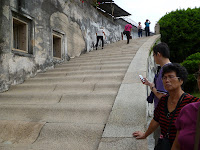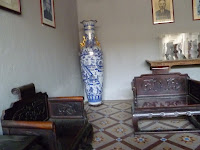Welcome to Swinging By
These are the places of interest that I've been to and I would like to share them with you. I hope you find them interesting too.
Monday, November 28, 2011
Ancient Jade Artefacts
We visited a museum called the Shinegood Culture Gallery which houses some of the most beautiful jade artefacts, all of which are between three to four thousand years old.A guide walked us through several chambers, telling us about the artefacts and where they came from.There are many more photos of the artefacts but I won't be sharing them as it takes far too long to upload. It was a real pleasure to see these lovely pieces of jade that have been so well preserved for posterity.
Saturday, November 26, 2011
The FengDong Rock
This is the entrance to the FengDong Rock.Perched precariously on the edge of a cliff, it is a scenic spot for photography.This Dongshan Fengdongshi Rock is actually a part of the ancient Tongshan city which was built in the Ming Dynasty. It used to be a fortress on a hill. The scenery here is very beautiful.Another ancient temple is found here, the Guandi temple, built during the Ming Dynasty. It is renowned for its beautiful carvings and is listed as a State Protected Historic site.Here is a close-up which shows the beautiful intricate carvings on the roof of the entrance to the temple.There is also a hall to commemorate the God of Wealth ( Choi San ) who has been acknowledged as the creator of the abacus.The grounds of the whole scenic spot are well-kept and there is an extended board walk which leads down to the beach..This is a signpost showing the whole scenic area.
Thursday, November 24, 2011
Qi Lu Fort, Shi Qi Lu Battery Park, Shantou
The Shi Qi Lu Park in Shantou, China, has a unique circular fort, the Qi Lu Fort, which was initiated in 1874 and completed in 1879.Its building was approved by Emperor Tongzhi in the Qing Dynasty. It is surrounded by a moat. It faces the sea and was the first bastion of defence for the city. 18 cannons both on the upper and lower levels are pointed seawards where the aggressors would approach. This fortification covers an area of 5.8 hectares.This fort has unique features. The upper level is flat while the base is arched. There are holes in the ceiling of the ground floor. These holes provided ventilation and allowed sunlight into the ground floor where the soldiers were.Soldiers stationed at the ramparts would use the ventilation vents which looked like little chimneys, to communicate with those on the ground. There are 72 of them altogether.They would shout for reinforcement or additional supplies of ammunition and their comrades on the ground would hasten to deliver barrows of ammunition or cannon balls, pushing them up the Ripple staircase.This Ripple staircase is ingenious as the 27 steps are rounded to enable the wheels of the barrows to be trundled up to the ramparts to deliver the ammunition.
This fort was later used as a military camp but in the 1990s it was turned into a
a commemorative park and it makes a picturesque background for photo shoots. It is also known as the Shi Lu Pao Tai Park.
This fort was later used as a military camp but in the 1990s it was turned into a
a commemorative park and it makes a picturesque background for photo shoots. It is also known as the Shi Lu Pao Tai Park.
Monday, November 21, 2011
Chen Chi Hong Residence, Chang Hai
This beautiful ancient mansion is a blend of eastern and western architecture. Commissioned in 1901 it has never been completed and now stands in isolated splendor in a remote village. It belonged to a gentleman called Chen Chi Hong and is known as the Chen Chi Hong Residence.
We had to drive through rough country roads, churning up dust as we passed plots of bananas, sugarcane, vegetables and other crops before arriving at this lovely mansion. It actually comprises four residences in a combination of western and classic Chinese style. It has never been lived in as it was never completed but now it has become a museum. Most of the rooms are empty. There are in total 506 rooms, quite mind boggling.Below is a diagram of the mansion.The windows are different in each residence, so too the stairs and floors which had lovely tile designs.One of the rooms showcases a chaoshan bridal chamber. There is also a sedan chair which was used to carry a bride. Red is an auspicious color for weddings.(Side view of the Sedan chair)
The spacious central courtyard has some old relics and a number of bonsai plants. There are also vegetable gardens outside the main perimeter of the mansion, most likely grown by the caretakers.
We had to drive through rough country roads, churning up dust as we passed plots of bananas, sugarcane, vegetables and other crops before arriving at this lovely mansion. It actually comprises four residences in a combination of western and classic Chinese style. It has never been lived in as it was never completed but now it has become a museum. Most of the rooms are empty. There are in total 506 rooms, quite mind boggling.Below is a diagram of the mansion.The windows are different in each residence, so too the stairs and floors which had lovely tile designs.One of the rooms showcases a chaoshan bridal chamber. There is also a sedan chair which was used to carry a bride. Red is an auspicious color for weddings.(Side view of the Sedan chair)
The spacious central courtyard has some old relics and a number of bonsai plants. There are also vegetable gardens outside the main perimeter of the mansion, most likely grown by the caretakers.
Han Wen Gong Temple, Chaozhou, China
This is the oldest temple in the Chaozhou area built to commemorate the famed writer Han Yu from the Tang Dynasty.Below is a diagram of the huge area in which the temple is located. There are steps out in the open, going upwards till the highest point which is where the temple is.His thoughts advocating good deeds are portrayed in a series of calligraphy along the covered walkways leading uphill to the temple which houses a large statue of him.There is also a garden which has lovely plants and statues.There is a huge statue of Han Yu in the temple at the top of the hill.There is also a bust of him in the garden.At the entrance leading to the temple grounds is a huge sculpture of a book on which is engraved his words of wisdom.
Subscribe to:
Comments (Atom)

















































